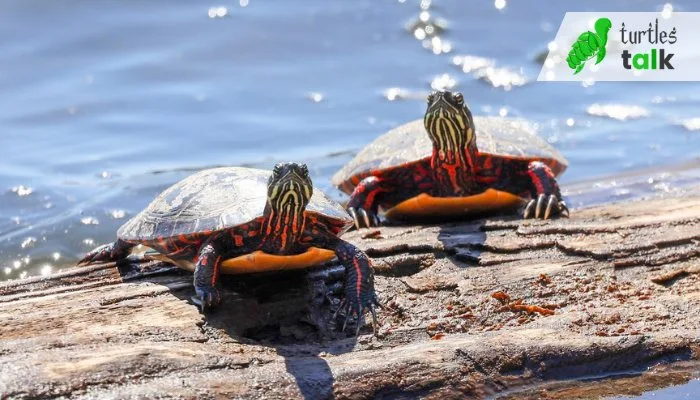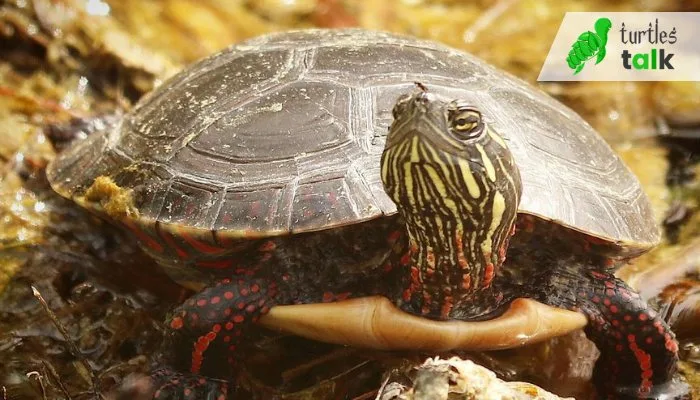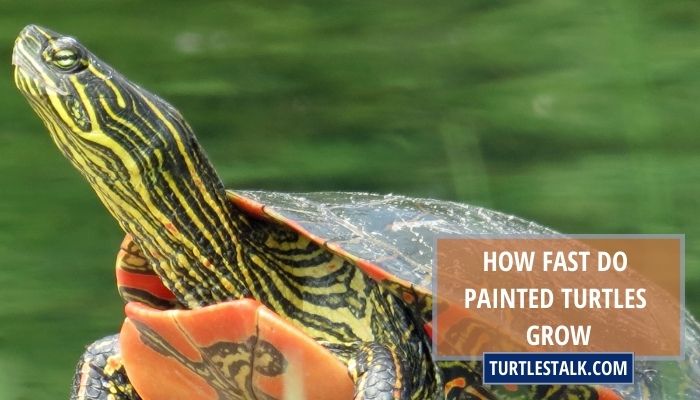How Fast Do Painted Turtles Grow? – Growth Stages of Painted Turtles
Painted turtles are a species of semi-aquatic turtles that are native to many parts of the United States and Canada. These turtles are popular in the pet trade due to their distinctive markings and ease of care. As such, many people are interested in understanding the growth rate of these turtles.
Hatchling painted turtles are typically about 1 inch in length and can grow up to 3-4 inches in their first year if provided with a nutritious diet and optimal temperature conditions. In subsequent years, growth rates tend to slow down, with turtles typically adding 0.5-1 inches in length per year.
It can take several years for a painted turtle to reach its full size. Generally, it is accepted that most painted turtles will reach their full size within 5 to 7 years. Some species may take up to 10 years longer or shorter times to reach their full size.
For instance, the Eastern-painted turtle is known to reach its full size in as little as three years, while the Western-painted turtle might take up to 9 years.
What Is the Growth Rate of Painted Turtles?
In the first year of a painted turtle’s life, it can grow up to 3 inches in length. They can grow an additional 2-3 inches during the second year. By the end of the third year, they can grow another 2-3 inches, reaching a total length of 8-9 inches.

After the third year, the growth rate slows down significantly, with an average growth rate of around 1 inch per year.
The growth rate of a painted turtle also depends on the sex of the turtle. Male painted turtles are generally smaller than females and may reach a maximum length of 8-9 inches, while females can grow up to 10-11 inches.
Here is a table that breaks down the average growth rate of painted turtles by age:
| Age | Length |
| 1 year | 3 inches |
| 2 years | 4-5 inches |
| 3 years | 6-7 inches |
| 4 years | 8-9 inches |
| 5 years | 10 inches |
| 6 years | 11 inches |
| 7 years | 11.5inches |
| 8 years | 12 inches |
| 9 years | 12.5-13 inches |
| 10 years | 13-14 inches |
Factors Impacting the Development of Painted Turtles
Painted turtles, also known as Chrysemys picta, are a common species of turtle found in North America. These turtles are known for their colorful shells and are often kept as pets.

The growth rate of painted turtles can vary depending on a number of factors, including their diet, habitat, overall health, and many other factors.
Temperature
Temperature is one of the most important factors that impact the development of painted turtles. Painted turtles are ectothermic, which means that the environment regulates their body temperature this means that the temperature of their surroundings heavily influences their growth and development.
For example, painted turtles that are kept at too-cold temperatures will have slowed growth and may become stunted. Conversely, painted turtles that are kept at temperatures that are too warm may experience accelerated growth but may also be at a higher risk of developing health problems such as metabolic bone disease.
The ideal temperature range for painted turtles is between 75 and 80 degrees Fahrenheit. It is important to provide a basking area with a heat lamp, keeping the temperature between 88-94 degrees, and allowing the turtle to regulate its body temperature.
Diet
Another important factor that impacts the development of painted turtles is diet. Painted turtles are omnivores and require a balanced diet of plant and animal matter to thrive.
A diet that is too low in protein or too high in fat can lead to a variety of health problems, such as obesity, metabolic bone disease, and shell deformities.
It is important to provide a diet that consists of a variety of fresh fruits and vegetables as well as protein sources such as worms, crickets, and small pieces of fish. Pellets and commercial turtle food are also good options as long as they are high-quality and provide a balanced diet.
Habitat
The habitat in which a painted turtle is kept can also significantly impact its development. Painted turtles require a suitable habitat, including a basking area, a place to swim, and a hiding spot.
A habitat that is too small or lacks these essential elements can lead to stress and health problems. It is important to provide a habitat that is large enough for the turtle to move around comfortably and has all the necessary components to meet its needs.
Health
The overall health of the painted turtle also plays a role in its growth rate. If a turtle is suffering from an illness or parasite, it may not be able to grow as quickly as it would otherwise. It’s important to take a turtle to a veterinarian if you suspect it may be sick so that the appropriate treatment can be given.
Gender
Gender plays a significant role in the growth of painted turtles. Generally, male turtles grow to be larger and more robust than female turtles. This is due to higher levels of testosterone, which encourages growth and strength.
Male turtles typically have a wider and longer plastron (bottom shell) compared to females, which helps them swim long distances in search of food and mates.
Female turtles are smaller and lighter, allowing for better agility and maneuverability in water, which can help them avoid predators.
What to Include in a Painted Turtles Diet to Ensure Proper Growth?
Painted turtles are a popular pet species known for their vibrant colors and easygoing nature. As with any pet, providing them with a well-balanced diet is important to ensure they stay healthy and happy.

Painted turtles are omnivores, which means they eat both plants and animals. In the wild, they typically eat a variety of aquatic plants, insects, worms, snails, and small fish. When it comes to feeding your pet turtle, it’s important to mimic this diet as closely as possible.
Protein Rich Diet
A diet that is rich in protein is essential for the overall growth and development of the turtle. Feeding them worms, crickets, mealworms, and small pieces of fish can provide the necessary protein for their growth.
Fruits & Vegetables
Fruits and vegetables should also be a part of their diet. Feeding them with leafy greens like lettuce, collard greens, and dandelion greens can provide them with the necessary vitamins and minerals that they need. They also like fruits like watermelon, strawberries, and raspberries, but these should be given as occasional treats as they contain high sugar.
Commercial Pellets
Along with the above-mentioned food items, you can also provide commercial turtle pellets as a staple diet. These pellets are formulated to provide your turtle with all the essential nutrients they need. However, it’s important to note that these pellets should not make up more than 25% of their diet, as they’re not as nutritionally complete as live or fresh foods.
Supplements
To ensure that your turtle is getting all the necessary nutrients, it’s important to provide supplements like calcium and vitamins. Calcium is particularly important for a turtle’s shell growth and development. You can provide calcium supplements by adding them to their food or by providing a cuttlebone.
Calcium Rich Food
A properly balanced diet should include a variety of calcium-rich foods for strong shell formation and proper bone development. Some good calcium sources include hard-boiled eggshells, cuttlebone, and reptile powder.
It’s important to remember that turtles can become picky eaters, so it’s important to provide a variety of foods in their diet. Rotating their diet every few days can keep them interested in their food and ensure they’re getting all the necessary nutrients.
What is the Average Maturity Time of a Painted Turtle?
The average maturity time of a painted turtle is around 8-10 years. This means that it can take up to a decade for a painted turtle to reach its full size and sexual maturity.
This can vary depending on the species. For example, the eastern-painted turtle (Chrysemys picta picta) has an average maturity time of between 8 and 9 years, while the western-painted turtle (Chrysemys picta bellii) matures at a slightly younger age of around 5 to 6 years.
The gender of the painted turtle can also play a role in the maturity timeline; males generally reach sexual maturity at a younger age than females. Temperature and food availability can also affect the rate of maturity, with turtles in warmer climates typically maturing faster than those in colder climates.
Do Painted Turtles Need to Be in Water to Grow Properly?
Painted turtles and their water habitat are crucial for their proper growth. These turtles are semiaquatic and spend ample time in water for various reasons. Water supports their growth, aids in thermoregulation, assists in excretion, and provides a suitable environment for feeding and mating. Without access to water, painted turtles may face difficulties in obtaining essential nutrients and hormones, hindering their overall development.
Conclusion
Painted turtles are a slow-growing species with a growth rate that varies depending on factors such as diet, temperature, and overall health. In captivity, they can reach full maturity within 8-10 years.
Proper care and nutrition are crucial for promoting healthy growth in painted turtles, and it is important to provide them with a suitable environment that mimics their natural habitat. Understanding their growth rate can help ensure that they receive the proper care they need to thrive.
Does the Growth Rate of Painted Turtles Affect Their Ability to Hold Their Breath?
Researchers have found that the growth rate of painted turtles can impact their ability to hold their breath. As painted turtles grow, their breathholding duration also increases. This is due to the development of their respiratory system, allowing them to stay submerged for longer periods of time.

